an













In media coverage of Jefferson, the “who” is often forgotten: this is who we are
Senior Nathan Cheng swings his driver off the first hole at Golf’s Regional Tournament. Cheng went on to compete in states to conclude his final season.


“It was fun, but it was also pretty bad since we lost districts for the fourth straight year in a row or second place in districts,” Cheng said. “Good luck to those who play next year. I hope we can win.”
PHOTO// E. Harris.



tjTODAY is the official newsmagazine of Thomas Jefferson High School for Science and Technology. The staff is deeply committed to a code of journalistic ethics that demands
the exercise of accuracy, good judgment, and impartiality. The content of tjTODAY is determined by the editorial board. Unsigned editorials reflect the majority opinion of the staff of tjTODAY, but not necessarily the opinions of individual editors.
BOARD Print and Online Editors-in-Chief Christina Lu Robert Stotz Eric Feng Aarya Kumar Grace Sharna Chris Yoo Team Leaders Anya Raval Lucas Ribero Keertana Senthilkumar Xixi Song Laura Zhang


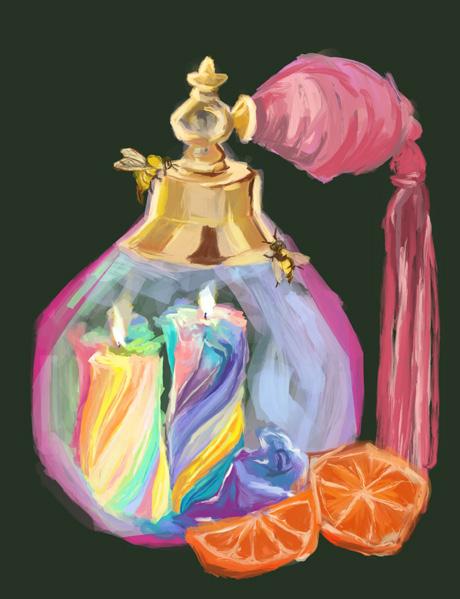



In competition, wushu requires Kooc maintains that his key to success in the sport remains
“After school, I would go to my facility and start train ing, just spamming flips and making sure I could do all of my moves without making any mistakes. I practice pretty much every day for about two hours. Improvement is pretty slow, but it’s a long process, and you just slowly get better over time,” Kooc said.
Kooc plans to continue competing at international tournaments next year, includ ing a potential competition visit to China. He says that his expectations going into next year may be a little different,
“My expectations for next year will depend on how much I train and how much I seem
to be improving, but I’m still hoping to make the team again,” Kooc said. “My ulti mate goal is still to go to world championships and win there. It’s a high goal but it is what I have wanted to accomplish for a long time.”
On the other hand, due to factors such as his health and time, Kooc is unsure about his future in the sport of wushu after his senior year. What ever the limiting factors may be, Kooc shows a degree of optimism about how he will be able to continue on.
“I’m not sure how long I can continue [to do wushu]. Unfortunately, I’m pretty injured right now, especially with a couple of knee issues. I don’t know how much longer I’ll be able to do it while I’m still injured, but I really want to do it for as long as I can,” Kooc said.
Kooc performs a skill with a wushu staff, known as a gunshu, during a competition in front of judges and an expectant crowd in 2019. Kooc has been participating in the sport since he was around two years old.



Faced with controversial news headlines and overwhelming statistics, students adress the incomplete picture of Jefferson painted by the outside world

Clutching the football, senior Justin Yoo sprints across the field during a game against the Beacon Hill Football Club. “People from my base school always ask, ‘Do you guys even have a football team? Does anyone there even play sports?’ Everyone just views us as nerds that only study,” Yoo said.
 PHOTO//Z. Baker
PHOTO//Z. Baker
Information about Jefferson’s nation al ranking, admissions process, and academic accomplishments is widely available online and in the news. How ever, amidst all of this, something is still missing — the stories of the students at Jefferson.
When senior Jerry Mao first set foot in Jefferson three years ago, he thought that school would consume his life.
“I thought that it would just be school 24/7, which proved to be very false after getting to know 8th periods and meeting friends who came here not for STEM, but for the different envi ronment where they’re surrounded by motivated students.” Mao said.
Although Jefferson is primarily known as a school for science and technology, it is not only for students interested in STEM.
“Before I came here, I thought that ev eryone wanted to pursue math. I would say that we’re passionate about STEM, but I’ve also met people that are passion ate about humanities, journalism, and politics. We love the classes that interest us,” Mao said.
Even though Jefferson students ded icate a significant amount of time to their academics, many also choose to pursue interests outside of school.
“People think that if you’re booksmart, you can’t do anything else, but that’s definitely not true, because a lot of people here are very good at many different things,” senior Trisha Naidu said. “That’s what TJ is: a bunch of people that attend for academics, but who are also doing sports and arts and dance.”
In an opinion article for the Washing ton Post, class of 1994 graduate Jona than Riehl describes Jefferson’s current environment as a “pressure cooker of competition whose temperature has now burst the thermometer.”
Riehl’s portrayal and other media coverage of Jefferson has led to the neg ative stereotype of Jefferson students as overworked and lacking social lives.
“Whenever I’m at debate tournaments or conferences, I’ll always tell people I go to Jefferson High School, because TJ sort of has this connotation attached to it,” senior Rushil Umaretiya said. “We’re all supposed to be brain dead robots that just grind all day.”
According to a survey conducted by Challenge Success in 2018, 53% of stu dents describe Jefferson as “difficult” or “stressful”. With similar statistics and stories present both online and among the Jefferson community, it can seem like students are only characterized by school.
“I thought that [Jefferson] would be like study, study, study. I feel like the surrounding stereotype is very focused on that, but it’s so much more vibrant, inclusive, and diverse,” Naidu said.
Although Jefferson students’ emphasis on school is often viewed negatively, some students choose to see their passion for learning in a more positive light.
“From an outsider point of view, a lot of people see us as these nerds. I mean, we are, and we’re proud of it,” Umaretiya said. “I do study all day, and I’m better for it. When I go to college, I know that the rest of my life will probably be easier.”
Junior Sahil Kapadia reaches in the air for the basketball. He enjoys surprising other schools with the abilities of Jefferson’s basketball team. “When I went to Chantilly High School for a basketball game, they all dressed up as nerds and had tape stuck to their glasses. It was nice because we beat them, so it was funny to see them walk out in their odd costumes,” Kapadia said.
Senior Jerry Mao participates in a taiko, or Japanese drumming, performance. “Taiko was my gateway drug. I practiced and played at iNite, and then I wanted to keep on doing it,” Mao said. “Taiko shifted to Japanese Culture Club my sophomore year, and I also got involved with JNHS.”
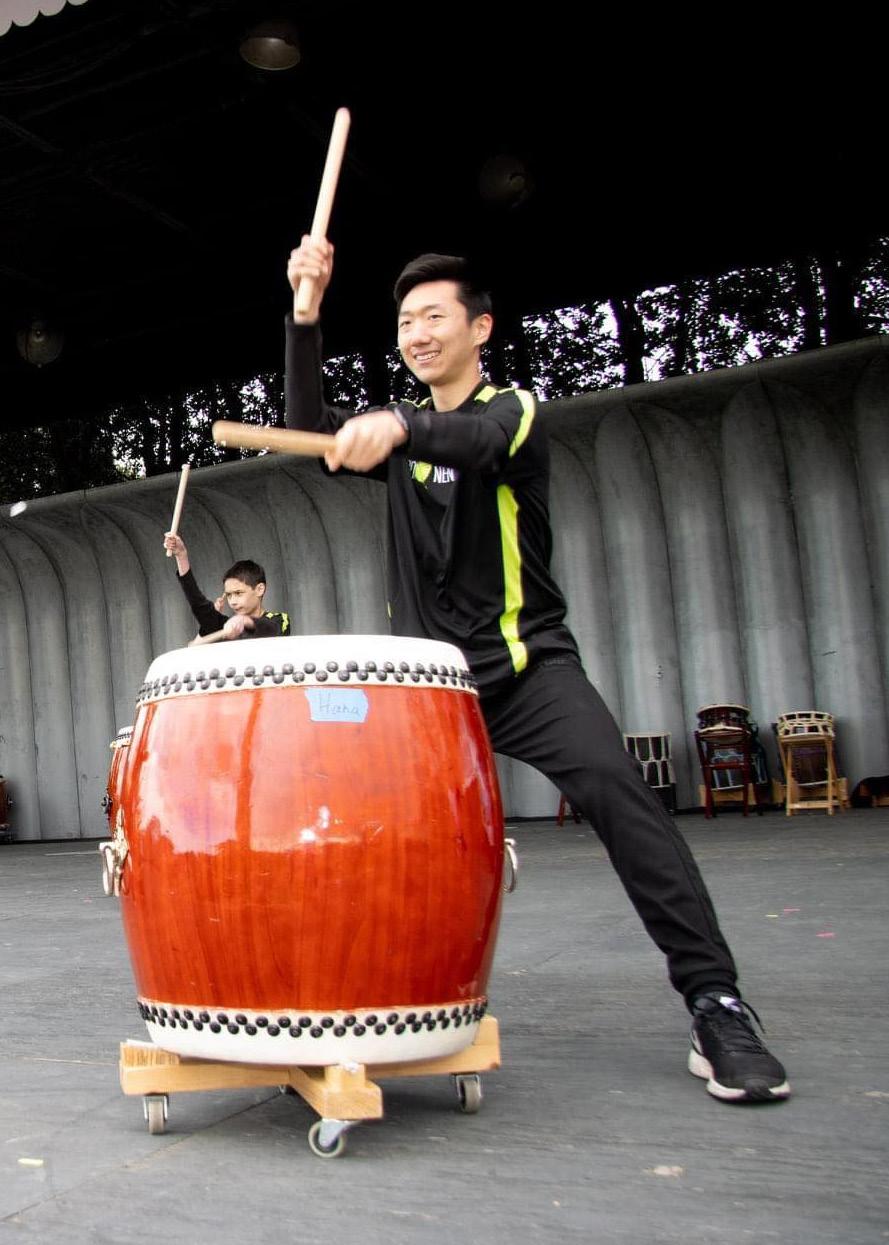
Even though many Jefferson students strive for academic success, they also support each other through this process.
“Talking to other people has really helped. Instead of keeping it all bottled up, I’ll text somebody about it. My friends are going through the same thing, so they understand,” junior Keya Shah said.
Students have also adapted to Jef ferson’s rigor by participating in non STEM-related activities.
“I think activities outside of STEM are a great opportunity to get a break from fully being academic centered and shape TJ students as all-rounders,” Naidu said. “For example, joining a sports team helps you find people in a close commu nity, which is really nice.”


Because many Jefferson students are passionate about their interests, clubs and sports teams are often very tightknit.
“TJ has a thriving extracurricular culture, and that’s definitely gotten me a lot more involved with life at school. Participating in TJ activities lets me get to know more people, and the more people I know, the more I feel like I fit in at TJ,” Mao said.
PHOTO//Z. Baker
Senior Rushil Umaretiya serves as the Student Government Association (SGA) president, which involves overseeing Jefferson’s student leadership teams.

“I have always been a huge advocate for my people. I’m always looking for an issue to speak out on and make everyone feel heard. I think that’s something that will carry with me through the rest of my life,” Umaretiya said.
Along with student government, Umaretiya is the principal bass player for Jefferson’s Symphonic Orchestra. He has also performed with Jefferson’s Jazz Band and theater department.

“Bass has been great. It’s fun, because it’s such a small group of people that play bass. It’s opened so many doors for me. I’m getting into a bunch of stuff with bass outside of school,” Umaretiya said.
“Learning a language is not just about the language itself. It’s also about experiencing the culture,” Naidu said. “For JNHS, I’m a publi cist. We work to spread awareness on Japanese culture and provide the opportunity for people to immerse themselves in the culture.”
Naidu also holds various roles in Jefferson’s Swim and Dive team as both an athlete and manager.
“This year, I’m planning on doing swim ming, managing, and photographing. I feel like I found a group of people that I can really connect to, because we all really love to swim. We’re just one big family,” Naidu said.
 The roles of student, athlete, performer and volunteer often coexist with one another
Senior Trisha Naidu’s participation in Japa nese National Honor Society (JNHS), Korean Culture Club (KCC) and Certamen stems from her love for languages.
trisha Naidu, 12
PHOTO//T. Naidu
PHOTO//R. Umaretiya
The roles of student, athlete, performer and volunteer often coexist with one another
Senior Trisha Naidu’s participation in Japa nese National Honor Society (JNHS), Korean Culture Club (KCC) and Certamen stems from her love for languages.
trisha Naidu, 12
PHOTO//T. Naidu
PHOTO//R. Umaretiya

Junior Keya Shah is the Activ ities Director for TJ Minds Mat ter, a club that works to spread awareness on mental health at Jefferson.

“I think we need to realize that at the end of the day, one class or one test isn’t going to matter. I tell myself it’s okay to not be okay, and sometimes I’ll take days off where I don’t do any homework, but that’s okay,” Shah said.
Outside of Jefferson, Shah combines her love for helping others and medicine by vol unteering at a hospital in the cardiac telemetry unit.
“I’ve learned how to inter act with patients and work in emergency situations,” Shah said. “Sometimes I’ll be getting five phone calls at the same time, but there’s only one person at the desk, so I’ve had to use my problem-solving skills.”
Junior Keya Shah helps students with a science project at a summer camp.

“I’m really passionate about trying to make a difference, anything big or small. I do a bunch of volunteering things, like working with nonprofits,” Shah said.
Students have developed a unique collection of words and phrases to describe their experiences at Jefferson
shaft (adjective)
Unfairly difficult or confusing “That test was so shaft.”
cise (noun, verb, adjective)
To provide academic help (without breaking the honor code of course). “Can you cise me?”
cracked (adjective)
Insanely skilled “I heard they aced the essay. They’re cracked.”
flex (verb, noun)
Acknowledging an accomplishment “That’s such a flex.”
An annual wave of sickness that sweeps across Jefferson in the fall because students are unwilling to miss school.
“The TJ plague must be going around. Half of my class was sick today.”
it’s in (idiom)
An announcement by a student that a grade has been entered into the Student Information System (SIS).
“I just checked SIS. It’s in.”
touch grass (idiom)
A nice way to tell someone to go outside nd get away from their homework and electronics. “He spent the entire weekend studying. He should really go touch grass.”
WebAssign (noun)
An online platform used for weekly physics assignments. Often used to make fun of juniors. “3, 5, 7, 9, at least we don’t have WebAssign.”
A mural of Jefferson takes up the better part of a wall at the local Firehouse Subs. “The fact that Firehouse Subs has TJ painted on their wall at the plaza behind the school, that definitely shows that we have a certain level of influence over them as well. Meeting up after school, the atmosphere provided to students by these stores, really helps with students’ spirit in general,” junior Amanda Wang said.
 PHOTO // K. Senthilkumar
PHOTO // K. Senthilkumar
You’re new to Jefferson. You reluctantly make a Facebook account, perhaps get tricked into believing the third floor pool exists–what next? You learn the way to local restaurants.
Jefferson students frequent a few hangout spots, from plaza favorites to restaurants a bit farther from school campus. Ocha Tea is one of those shops, located on Little River Turnpike, and gets a rush of visitors on evenings after school.
“We do get a lot of students after football games, or before the football games. Sometimes cheerleaders would come but right now it’s mainly the track students,” Ocha Tea employee Bryce James Machie said. Small stores, including Ocha Tea, are especially impacted by Jefferson customers.
“I would say they definitely helped with our sales, because right now, the store’s not doing so well,” Machie said. “But having the students that do come, they do help.”
Not only do students support local businesses, but businesses also support students through fundraisers. At the end of the last school year, TJ Space program, formerly Nanosat, needed to raise money to attend the

“We were the only team that [was] representing a high school and then obviously student travel was very expensive. So that’s why we decided that we needed to do some fundraising to support our trip to Utah in August,” TJ Space project director Amanda Wang said.
To collect the money, TJ Space program sold bubble tea from Tan-Cha tea, located about a mile away from Jefferson. Their J-day booth sold out completely just as the day ended.
“We sold 300 teas. I think we made about $1500. We did sell pretty much perfectly on time,” Wang said.
Another Jefferson club, TJ LaunchX, held a successful fundraiser at Five Guys on the day of the annual Homecoming game.
“I would say there was a lot of turnout. When I was there, I saw a lot of TJ kids,” junior Evan Huang, LaunchX fundraising coordinator, said.
These partnerships strengthen the connections between the school community and the community around Jefferson.
“I feel like there’s definitely [a] mutual benefit between local businesses and TJ students,” Huang said. “On one hand, TJ students, they have a place to eat and socialize after football games. The businesses get extra revenue from all these TJ students. And it really helps boost the community.”
PHOTO // A. WangPrototyping. Energy Systems. Robo. Automa tion. These four labs are, and have historically been, separate. Yet they all have something in common: the Engineering Design Process. To unify these under a common umbrella, robotics teacher Kristen Kucko is leading an initiative to allow stu dents to work in multiple labs at a time.
“TJ Engineering is a lab experience where students who have taken any two engineering electives can spend their senior year designing and building a project,” Kucko said.

This allows students to undertake more complex multi-disciplinary projects.

“For instance, in the Robotics Lab, students can start their project by rapid prototyping and enhance those prototypes with sensors and Arduinos. Once the prototype is finalized, the students can manufac ture their parts using the fabrication equipment in the Prototyping Lab,” Kucko said. “In Energy Sys
tems and Electronics, students can learn how to power and propel their projects. Finally in the Automation Lab, students can apply computer vision and AI to make the project autonomous.”
Kucko explains that this approach better mirrors what students will find later in their professional lives.
“In life, problems are solved by cross func tional teams. They are solving problems using the Engineering Design Process and gaining hands-on experience,” Kucko said.
Part of the inspiration for TJ engineering is the growth of long, multi-year engineering projects. Through TJ Engineering, students participating in those projects will be able to continue the work they’ve done extra curricularly as underclassmen during their Senior year lab experience. Effectively, their engineering extracurricular, be it TJ Space,
A new initiative, TJ Engineering, will make it easier for students to work across labs
Rocketry, Automotive Engineering or TJ Unmanned Aerial Vehicle (UAV), could become their senior research lab.
“Students have shown a growing interest in aerospace as demonstrated by the popularity of TJ Space, TJ UAV and Rocketry [Club]. The Engineering Research Lab allows students the flexibility to build a project and access all three of the labs. TJ’s engineer ing program recognizes that student’s interests are evolving, and that the engineering classes need to evolve to better support the needs of the students,” Kucko said.
Senior Aditya Vasantharao is a member of TJ UAV, one of the clubs that’ll benefit from the proposal. He participated in some of the conversations that helped inspire the idea, and mentions that the abilities learned in Jefferson’s engineering classes go hand-in-hand with work done at clubs.
“The stuff you learn in Robo, Analog, and Digital fits well with the [extracurricular] engi neering teams,” Vasantharao said.
TJ Engineering is similar to university initia tives.
“At Cornell, they have engineering project teams, which is a unified front for their engineering pro gram,” Vasantharao said.
The program hints at greater advancement in TJ’s engineering domain.
“It’s kind of symbolic of what this new era of TJ is going to be. There are clubs with 50-60 people [each] trying to do crazy things that no other high school and even some college students have never done before,” Vasantharao said. “This type of thing hadn’t happened before at TJ, so this is a step in the right direction.”
(Center) Junior Shaun Fallon welds a part in the Prototyping Lab. TJ Engineering would give those in other labs access to tools such as weld ing stations, which as of now are available only in the prototyping lab. PHOTO// L. Ribeiro
(Top Right) Juniors Vayun Malik (Left), Christo pher Lim (Middle), and Manav Gagvani (Right) work on a self-driving component for Automo tive Engineering, in the energy systems lab. PHOTO// L. Ribeiro

(Bottom Right) Senior Lauren Fisher 3D prints an object in the Robotics lab. PHOTO// L. Ribeiro

(Bottom Left) Senior Jonluke O’Cain uses a pneumatic grinder to cut a coil in the prototyp ing lab. PHOTO// L. Ribeiro

The crisp autumn air. Cheering crowds. Early mornings before the sun has risen. Hours of stretching, warming up, and prepping. Every thing has led to this moment.
“Ready,” the umpire's voice echoes through a megaphone. “Set.”
A high pitched beep sounds out. Junior Aurora Richard lives for the rush of pushing her feet off the ground and sprinting down the track as fast as she can. With nothing to focus on but her tech nique and the cool air of upcoming winter, track has helped her in more ways than one. This year, she has begun private lessons outside of the indoor and outdoor track seasons.
I hope to get recruited,” Richard said. “I want to go to a college that has a major that I'm interested in, but my second priority is if they have a good track team. I’ve always hoped that I would pursue a sport in college, whether it be on a D1 or D3 recruited, intramural, or club sport.”
Richard's journey began as a child. She always knew she would do a sport in high school, but what she didn’t know was that the sport would become her main source of serotonin, stress-relief, and motiva tion.

“Because of my older brothers I was always an athletic kid,” Richard said. “I always thought that I would do track in the winter and play soccer in the spring like them. But I started my freshman year with win ter track and I really liked it and all the people that I met, [so] I decided to continue doing it in the spring.”
Today, track has become more than just a sport for Richard. After about two hours of practice a day for two seasons a year, track is a fundamental part of her life.
Sprinter Aurora Richard begins private training outside of winter and spring track seasons in junior year to improve before college recruitment By Grace Sharma“I love the feeling of sprinting, especially this time of the season when it starts getting cold,” Richard said. “It's nostalgic. I really enjoy being outside—the fresh air and the crisp sharpness in my lungs is really refreshing. I don't really think of anything when I'm running. It clears my head.”
After graduating, Richard hopes to continue her track career in college.

“My brothers got recruited for soccer in college, and I really liked how they've kept their friends and formed really strong bonds and re lationships because of their sports,” Richard said. “I want that, too.”
However, due to the demanding nature of getting recruited for college, Richard has begun private training outside of the season.
“I'm trying to run in college, so I have to take track more seriously. I have to train harder,” Richard said. “I still enjoy it, but I need to get certain times and there's a very strict performance that's required
of me to be able to run in col lege.”
During the season, track practices are five days a week with a meet every weekend. In addition to this, Richard has been doing private training to improve her times be fore the winter track season begins.
“I did some training during the summer by myself, but it's really hard to get the right workouts and know that they're actually benefiting you without more knowledge and experience like a trainer,” Richard said. “I fixed my diet and my sleep schedule over the summer.”
After realizing she needed a train er to help her plan her workouts and get enough motivation, Richard hired one and began to train even more rigorously during the fall.
“Every day I do a track or gym workout,” Richard said. “One day a week I do nothing, which I think of as recovering so I can get ready for the next week of training.”
She meets with her trainer every Sunday and has already begun to see her times decrease with the extra training.
“Having a trainer who gives me workouts and will help me with the admission process, recruitment, and college offers has been really bene ficial,” Richard said. “I already think I've started dropping my times and correcting my running form a lot.”
"Having a trainer who gives me workouts and will help me with the admission process, recruit ment, and college offers has been really beneficial."
 By Grace Sharma & Xixi Song
By Grace Sharma & Xixi Song
Horror captures society’s fears at the time it was written and immor talizes it. Beginning with roots in Ancient Greek and Roman literature, European-centric horror stories in clude the werewolf, also known as ly canthrope, and the Salem witch trials. The first gothic novel published that founded the horror genre we know today is the “Castle of Otranto” (1764) by Horace Walpole. Though the novel contains many unaccept able themes in current day (it follows a father who attempts to rape his son’s wife in attempt to get her pregnant), it was the initial catalyst for the exponential growth of horror.
Written by Mary Shelly in the early 17th century, “Frankenstein” was the first known science fiction novel, but contains common horror themes. It tells the story of an artificial creature that overturned its creator. “Fran kenstein” opened the doors to later works such as the famous horror novel “Dracula,” and influenced the views of society through its overar ching theme that people should be cautious of their actions. It was later turned into a movie, which was an Oscar nominee.
When “The Monk” by Grego ry Lewis was released in 1796, it quickly became one of the most popular books at its time. The nov el included revolutionary scenes of decaying babies, incest, and preg nant nuns, which had never been
put in a novel before. Due to this, it was considered extremely contro versial at the time, but many people were intrigued by its scandalous themes. Although “The Monk” was not the first horror novel, its eccen tricity often earns it that title.


Vampires were introduced to horror through “The Vampyre,” a short story by John William Polidori in the early 17th century. Later that year, two of the most popular vampire novels to this date were published: “Carmilla” by Sheridan Le Fanu and “Dracula” by Bram Stoker. These stories contin ue to capture the public’s attention decades later and have been adapted into hundreds of films, influencing all forms of modern entertainment.
Vampires dominated entertainment for decades, including the twentieth century vampire craze of the “Vam pire Diaries,” “Buffy the Vampire Slayer,” and “Twilight.”

A horror novel that revolves around melancholy, “It” by Stephen King is one of the most popular horror novels of all time. Not only was it terrifying, but the novel also managed to sympathize with many readers. In 2019, “It” was turned into a film,
becoming a major success in different countries. King is valued as one of the great est horror writers, and was honored at the White House in 2015 with a National Medal of Arts.
Widely considered one of the top horror films of all time, the “Exorcist” (1973) was adapted from William Peter Blatty’s novel by the same name. With ten Academy Awards, seven Golden Globes, and one British Academy Film Awards
(BAFTA), the “Exorcist” has undoubtedly impacted the horror genre today with its memorable soundtrack, visuals, and religious commentary. Its styles are replicat ed across all genres and media of entertainment.
Regan MacNeil, a teenage girl, is possessed by a demonic being in this scene of “The Exorcist” (1973). Spiritual possession is a state where the mind is unconscious, but the body moves under supernatural influence. A subject in this state will typically be equipped with abnormal strength. This is true for Regan, as she committed homicide while possessed. However, when Regan was relieved from the demon, she no longer held any memories of her unconscious state. PHOTO // The Exorcist (1973)
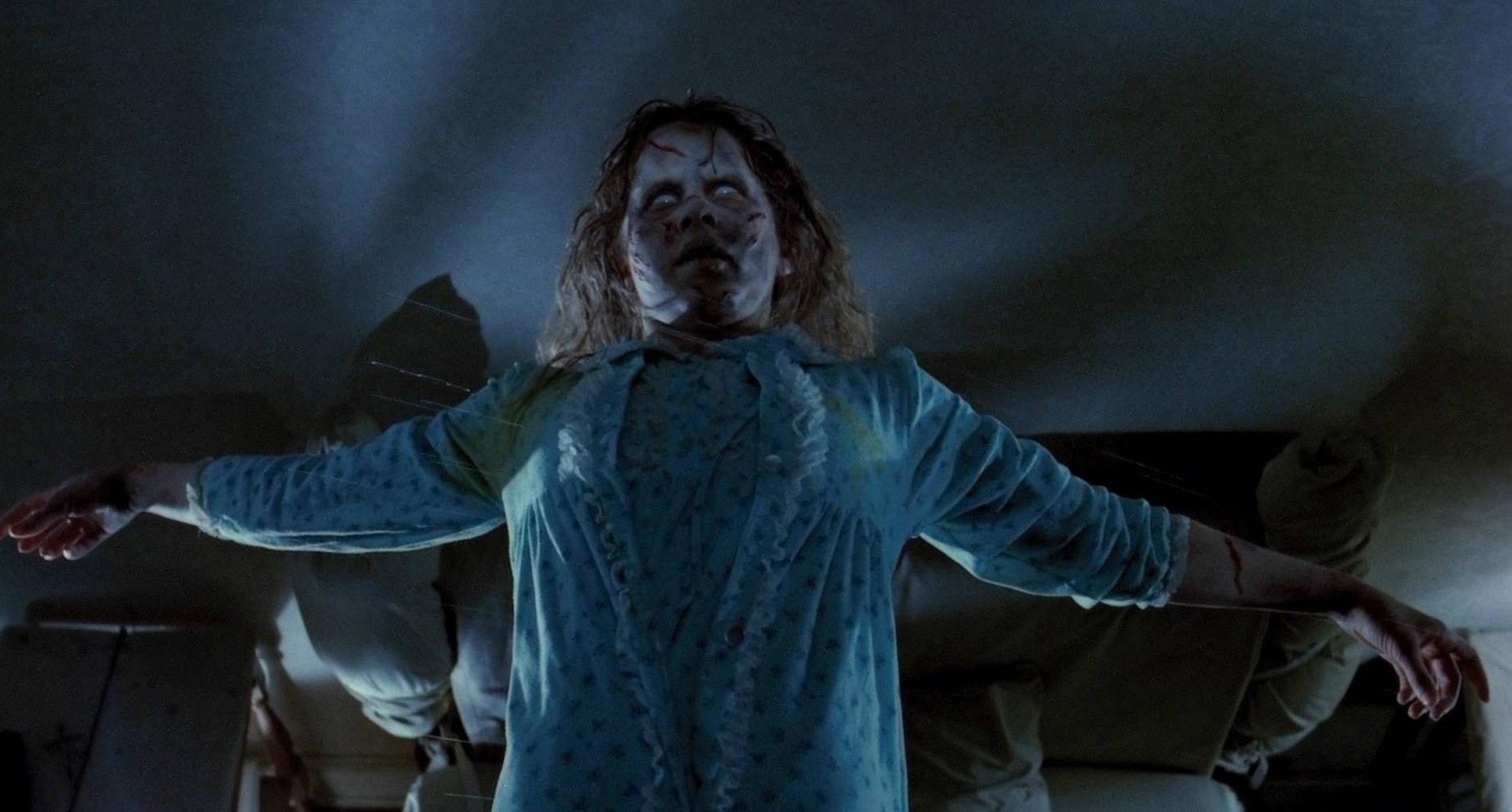
Even though Bath and Body Works fall candles are popular, many of this year’s candles were a miss
With every fall season comes the annual introduction of Bath and Body Works' signa ture candles. Each of the ten candles smelled was ranked on the overall smell and how well the candle encapsulated fall.
Leaves- The most accurate portrayal of fall, this candle gives off a combination of apples, cinnamon, and nutmeg. However, the name “Leaves” is misleading, as the candle smells nothing like the expected smell
of rain and nature.
Pumpkin Bonfire- The smell brought back many memories of a smoky bonfire, but it had the undertones of pine blur ring the line between fall and Christmas. Despite smelling
Anya Raval Team Leader

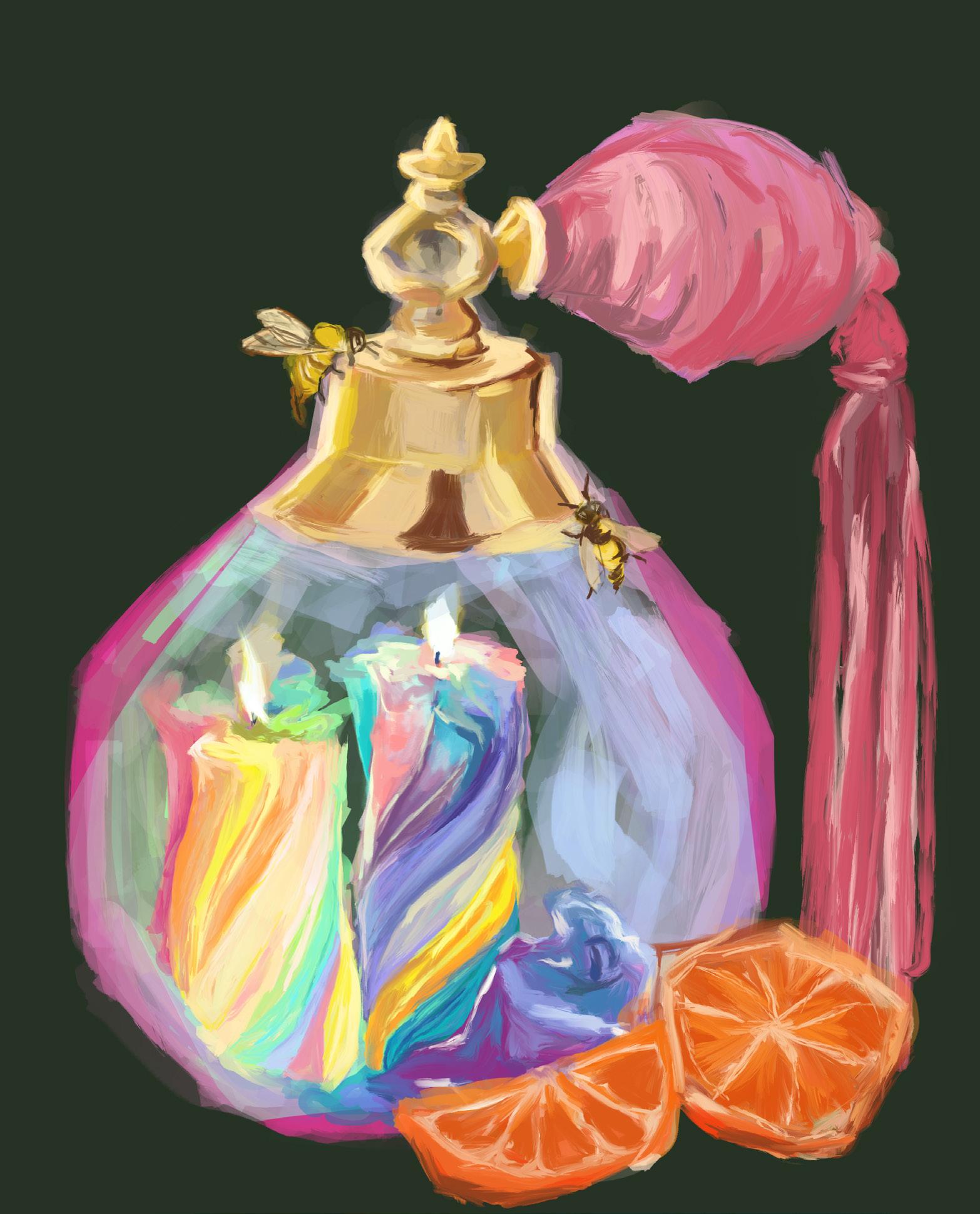
the best, it was ranked second because it didn’t completely smell like fall.
Marshmallow Fireside- It has a very sweet smell, just like the name suggests, but it would be a lot better if the scent was stronger due to the fact that there was no distinct smell to the candle.
Sweet Cinnamon PlumOut of all the candles sampled, this fragrance was a refreshing burst of plums, apples, and dried fruits in contrast to the sweet, muted smells of the previous candles.
Flannel- This candle can be described in one word- co logne.
Salted Butterscotch- This candle was honestly way too overpowering with the car amel that it almost smelled like expired butterscotch candy.
Fall Farmhouse- Even though this candle had the essence of fall and a pleasant scent of mint lingering at the end, it was slightly musky because the earthy spices slightly overpowered the scent.
Pumpkin Pecan WafflesDefinitely the worst smell out of all the candles smelled. The name was misleading because it was far from the expected scent. It smelled like a waffle overdosed with butter and pecan. The scent was too overwhelming and chaotic that it felt like a headache.
ILLUSTRATION// E. Li Ashley Hwang Staff WriterProtests are an essensial tool of making our opin ions known, but we must also consider its impact on schools
Geosystems is offering a field trip for extra credit, but is it really worth it?
Grades, at their core, are a balance between studying and other activities. This is espe cially true for seniors during the college application season, where it can be easy to hyperfocus on essays and common apps. However, grades are also something of which we should not lose track, and Geosystems is offering a field trip for extra credit for seniors that have fallen behind in coursework. But are the rewards given by the field trip worth the effort in this critical month?
FCPS respects the rights of our students to engage in peaceful protest and express their opinions through speech and other ways as long as it…does not disrupt learning in the school.”
A statement made by FCPS in 2018, provid ed to schools prior to student demonstrated walkouts. However, it should be considered as to what exactly “disrupts learning in school.”

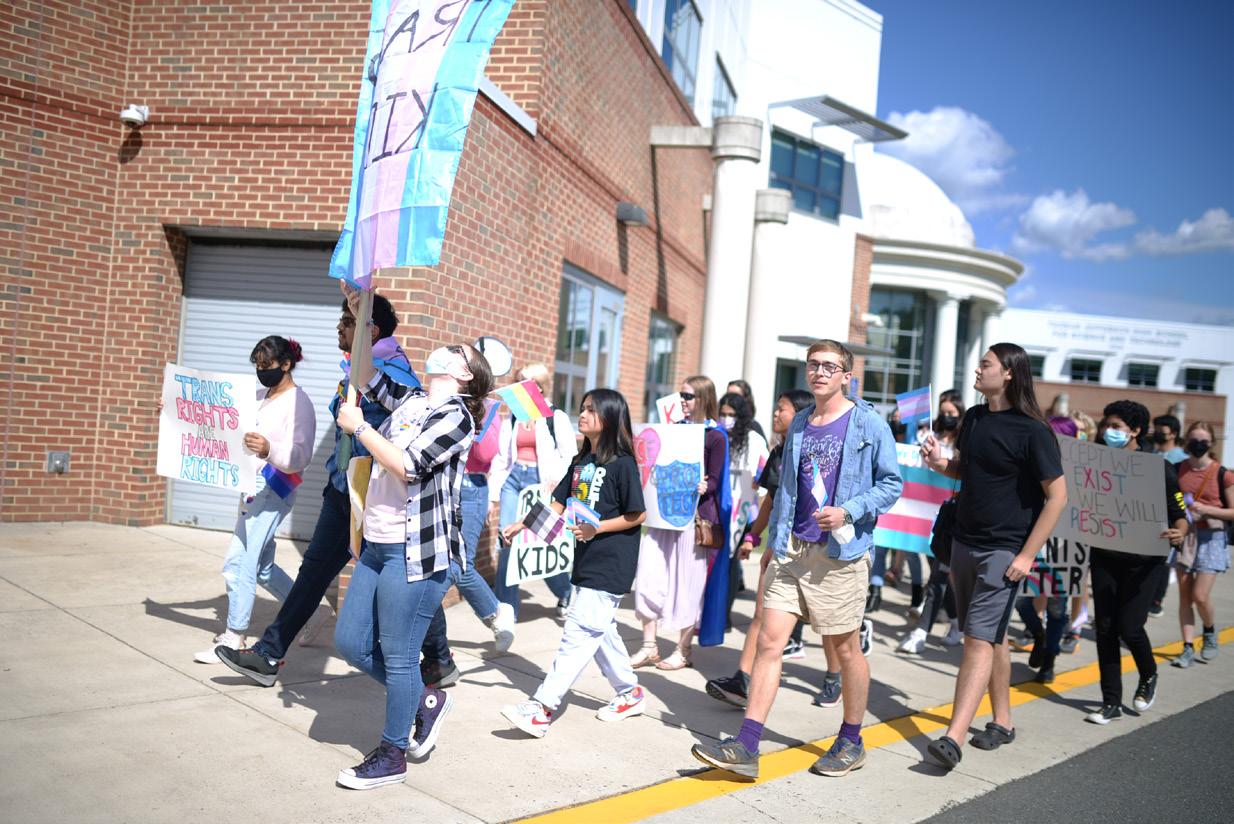
Many right-wing sup porters have voiced that student-led movements during the school day are disruptive by nature. As stated in a Washington Post article published

in 2019, “self-iden tified conservatives throughout the country argue students belong in school, not in the streets protesting.” A major target of this criticism was FCPS’ policy that allowed students to have “civic engagement days.”
The broadness of the term “civic engagement” was the basis of their argument, claiming it made the policy seem like an unorganized initiative where students are not using their time productively.
I believe that stu dent-led movements are not inherently disruptive. Much of the self-identi fied conservatives’ criti cism could be attributed to the fact that student protests are usually in support of liberal causes.
As a result, and so they don't want liberal
agendas and voices being heard.
I believe the words of the FCPS policy itself can be praised for determining if a protest is disruptive. “Peaceful” protest can be a quali fication to an extent so that students do not ver bally or physically abuse other students. Addi tionally, “expressing [stu dent] opinions through speech” is important to ensure that there are no physical expressions of opinion or anger.
To dispel the belief that all student movements are disruptive, it would be important for policies to provide examples of conservative civic engagement activities. However, specific move ments can be disruptive if they become violent.
Geosystems offers this trade: three percent extra credit for a field trip and a five hun dred word essay with pictures from the field trip site. The extra credit would be able to bump up a letter grade if they messed up on a test or assignment. While extra points are always enticing, in reality, with only 128 total points for the first quarter, the field trip would only be worth four bonus points, a rather measly reward for an activity involv ing many different parts, a 500 word summa ry, and a hike past nondescript forests and streams.
Is that much effort worth the four points in geosystems? And, more importantly, can everybody find the time to do the work?
Despite the warnings of an onset of se nioritis, in the first semester, schoolwork for us seniors is quite intense as these will be the last bit of grades that impact our regular col lege applications. Most seniors will apply for about seven to eight colleges, and the work that comes with it is not insignificant. Thus, the time that we have should be used wisely in order to optimize our college applications.
The field trip system, in the end, isn’t inherently good or bad; it’s just a tradeoff between time for college essays and grade improvement. For any senior interested in taking an extra credit field trip, you would have to keep in mind what you gain and what you lose.
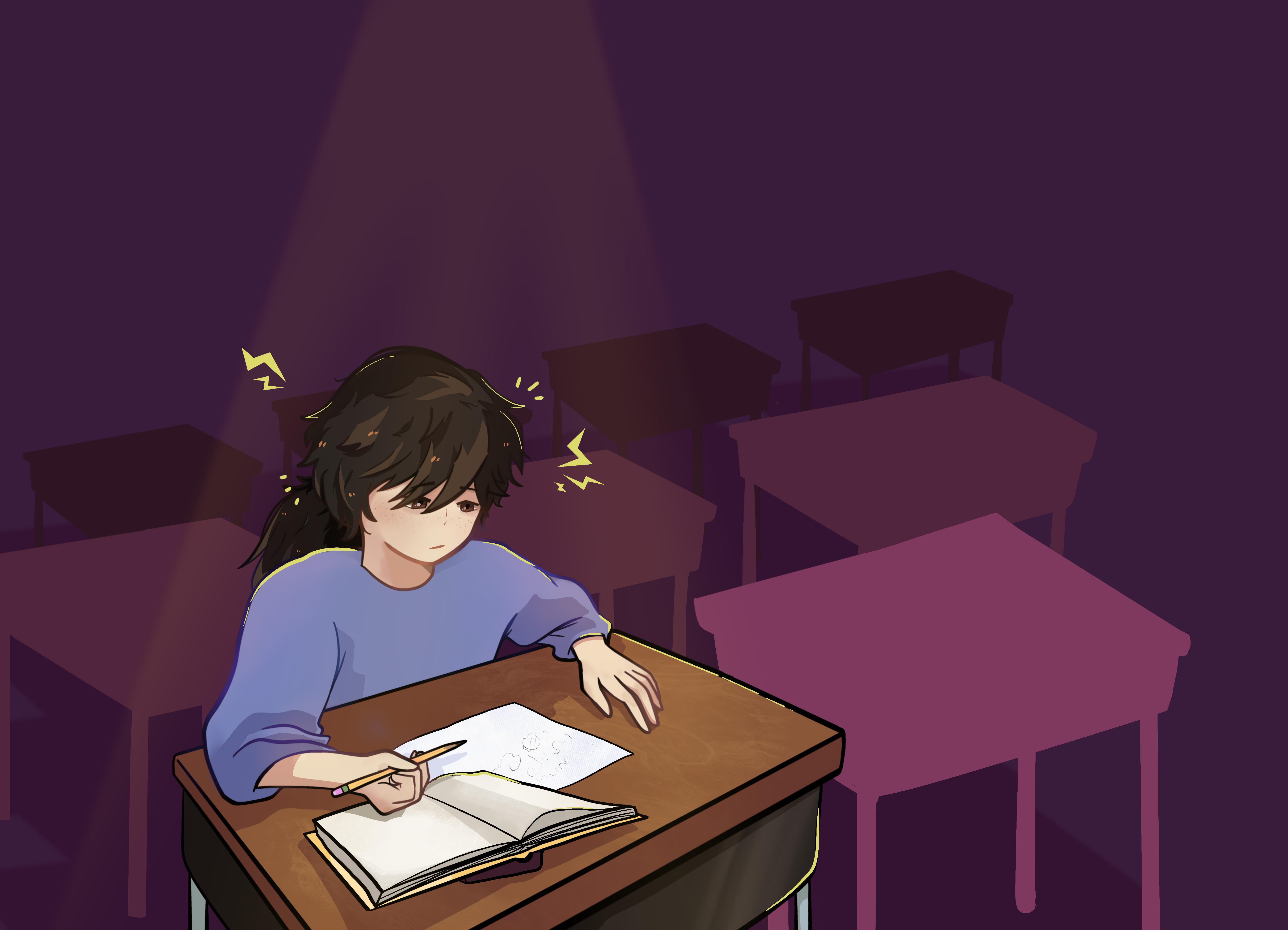
In an ideal world, a solely mer it-based system would be fair. But so many factors — from our school district to our genetic risk for reading difficulties to our situation at home — all influence our ability to succeed in this world. Policies to provide equal access to public education, changes to highly sought-after admission to prestigious schools, and programs to enrich the learning of under served communities have all tried to address educational inequity. Still, we’re miles from fair. The debate encompasses affirma tive action in higher education, TJ admissions, and even AAP programs in ele mentary school, with a central question: how late is too late to make a difference? Do these interventions only superficially cover the symptoms of the root problems?
Each level of educa tion builds off of the previous. As time goes on, the gap in knowl edge only becomes wider. It’s not optimal for colleges to carry
the load of increasing opportunities for underrepresented communities — at that point students have already completed primary and secondary ed ucation — but the role colleges play is crucial as long as the problem persists.
At the same time, elementary and middle schools should take greater re sponsibility given that those formative years in education are so formative. In addition, TJ’s position as a magnet school gives it a unique ability to make a difference, at least within the local community.

Through the implementation of a ho listic review admissions process, we’ve increased the diversity of our student body. Some stakeholders have voiced concerns that such changes sacrifice the quality of education TJ provides, but let’s redefine success at TJ: not as a #1 national ranking or the percent of students taking multivariable calculus by 12th grade, but as a community that encourages love of learning and appreciates unique talents and pas sions.
Educational equity is not a problem that can be resolved quickly or with a single change. It can, however, be addressed throughout the course of a student’s educational career to even the playing field as much as possible. While current systems working toward this goal may not be enough, flawed efforts are better than none at all.
The complex nature of educational equity bars any one solution from resolving the issue; any effort is better than nothing
“In ninth grade when I took bio, that wasn’t really it for me. When I did computer science, I felt it was more entertaining than memorizing bio and chem, so I feel it guided me toward CS.”
“I heard about [quantum computing] at home, and was exploring it on my own. When I got into TJ, I was pressured to join a club, so I joined Quantum Computing Club. And I feel like that really furthered my interest and gave me a deeper understanding. [Quantum Computing Club] gave me a sense of community. It provided a mentor and a community that really helped me explore the field more. If I was in a different school, I feel like I wouldn’t be able to get that sense of STEM and all these related topics.”
“I’m teaching quantum computing to other kids outside of school. [When teaching] I learn a lot about technology and how everything fits together; something I learned from quantum can be applied to chem. I can use computer science to model the AP Physics Drag Lab.”
“[Jefferson] is a community where I’ve been able to not only explore my own interests, but also how people and technology come together in the real world.”
by Robert Stotz REPORTING by Robert Stotz